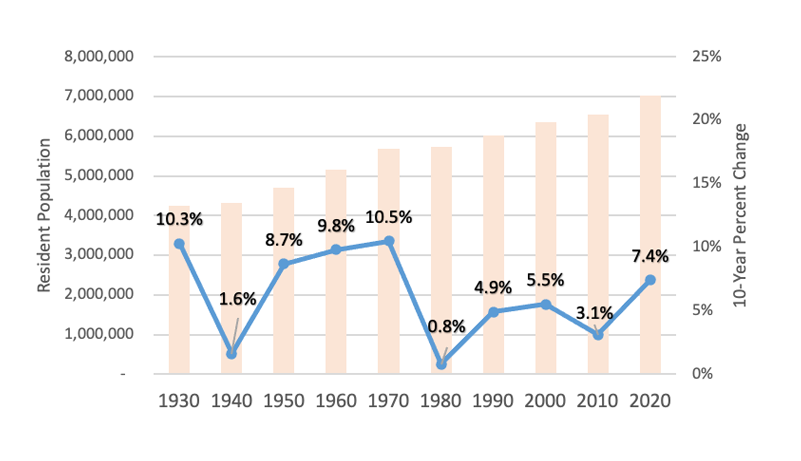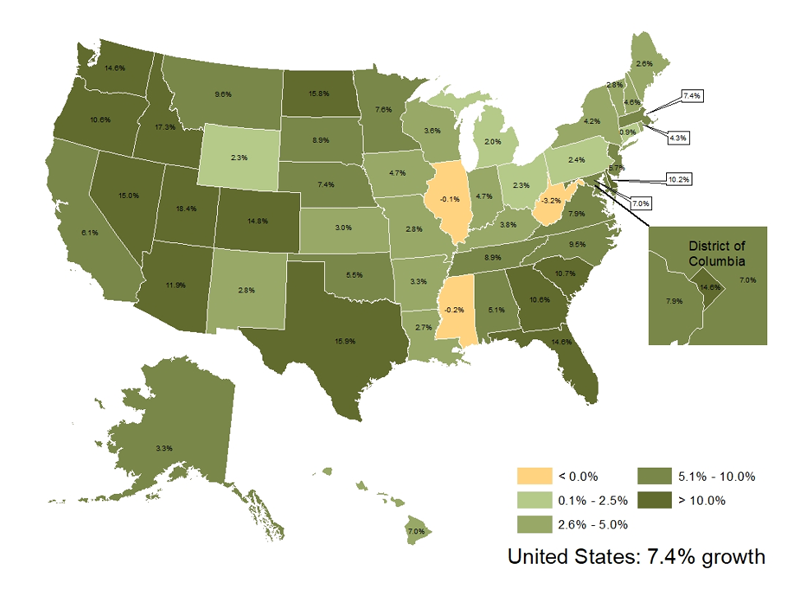Donahue Data Dash: The U.S. Census Bureau Releases 2020 Apportionment Population Counts for Massachusetts
May 2021
On April 26, 2021, the U.S. Census Bureau released the Census 2020 apportionment data, including the resident population, overseas population, and total population enumerated for each state in the 2020 decenial Census. State total population counts, including overseas population, are used to apportion congressional seats among the 50 U.S. States while resident population counts (excluding overseas) are used to determine the population in each sub-state legislative district.
According to the Census apportionment data, the Massachusetts resident population increased by 482,288 people, from 6,547,629 counted in 2010 to 7,029,917 in 2020. This 7.4% increase in represents the fastest decade-to-decade growth Massachusetts has experienced since the 1960’s, when the resident population increased by 10.5% from 1960 to 1970. As context, the Massachusetts population increased by 3.1% from 2000 to 2010 and by 5.5% from 1990 to 2000 (Figure 1). The total apportionment population count for Massachusetts includes an additional 3,552 overseas population, bringing the full apportionment count to 7,033,469.
Figure 1. Massachusetts Resident Population and 10-Year Percent Change 1930-2020
Figure description.

Source Data: U.S. Census Bureau, Change in Resident Population of the 50 States, the District of Columbia, and Puerto Rico: 1910 to 2020, April 26, 2021
Massachusetts ranked 21st in 10-year percent population change from 2010 to 2020, ahead of all other Northeast states and the Northeast average of 4.1%, and on par with the U.S. average of 7.4%. (Appendix A).
Map 1. Percent Change in Resident Population by State, 2010-2020
Figure description.

Source Data: U.S. Census Bureau, Change in Resident Population of the 50 States, the District of Columbia, and Puerto Rico: 1910 to 2020, April 26, 2021
The United States, as a whole, grew at a slightly slower pace from 2010-2020, 7.4%, than it did from 2000-2010, 9.7%. From 2010-2020, three different states, Illinois, Mississippi, and West Virginia, saw a decrease in their resident population compared to only one state, Michigan, in 2000-2010. Only 12 states and the District of Columbia saw population growth greater than 10% from 2010 to 2020 compared to 19 states in the 2000-2010 period. Higher population growth continues to be concentrated in the western and southern regions of the U.S.
For more information on the Census Bureau’s Recent Apportionment Population Release, see: https://www.census.gov/data/tables/2020/dec/2020-apportionment-data.html and the UMDI Summary Report and Appendix available here for download.

